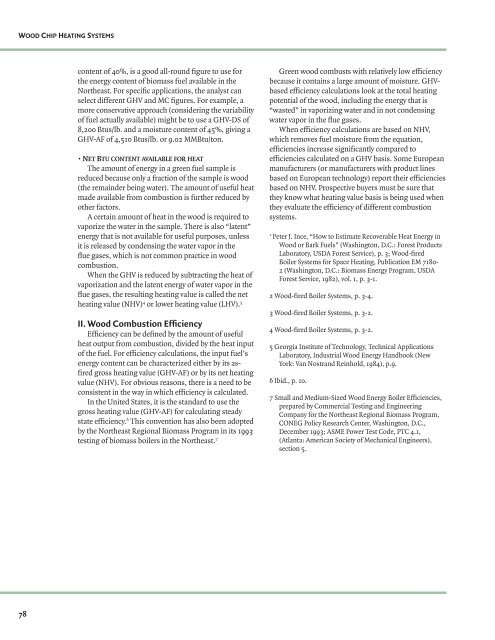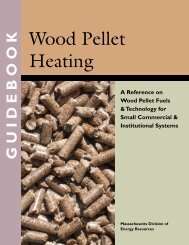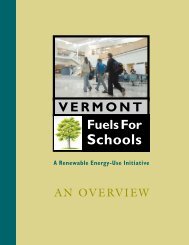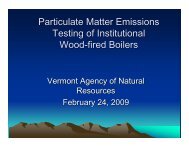Wood-Chip Heating Systems - Biomass Energy Resource Center
Wood-Chip Heating Systems - Biomass Energy Resource Center
Wood-Chip Heating Systems - Biomass Energy Resource Center
You also want an ePaper? Increase the reach of your titles
YUMPU automatically turns print PDFs into web optimized ePapers that Google loves.
WOOD CHIP HEATING SYSTEMS<br />
78<br />
content of 40%, is a good all-round fi gure to use for<br />
the energy content of biomass fuel available in the<br />
Northeast. For specifi c applications, the analyst can<br />
select different GHV and MC fi gures. For example, a<br />
more conservative approach (considering the variability<br />
of fuel actually available) might be to use a GHV-DS of<br />
8,200 Btus/lb. and a moisture content of 45%, giving a<br />
GHV-AF of 4,510 Btus/lb. or 9.02 MMBtu/ton.<br />
• NET BTU CONTENT AVAILABLE FOR HEAT<br />
The amount of energy in a green fuel sample is<br />
reduced because only a fraction of the sample is wood<br />
(the remainder being water). The amount of useful heat<br />
made available from combustion is further reduced by<br />
other factors.<br />
A certain amount of heat in the wood is required to<br />
vaporize the water in the sample. There is also “latent”<br />
energy that is not available for useful purposes, unless<br />
it is released by condensing the water vapor in the<br />
fl ue gases, which is not common practice in wood<br />
combustion.<br />
When the GHV is reduced by subtracting the heat of<br />
vaporization and the latent energy of water vapor in the<br />
fl ue gases, the resulting heating value is called the net<br />
heating value (NHV) 4 or lower heating value (LHV). 5<br />
II. <strong>Wood</strong> Combustion Effi ciency<br />
Effi ciency can be defi ned by the amount of useful<br />
heat output from combustion, divided by the heat input<br />
of the fuel. For effi ciency calculations, the input fuel’s<br />
energy content can be characterized either by its asfi<br />
red gross heating value (GHV-AF) or by its net heating<br />
value (NHV). For obvious reasons, there is a need to be<br />
consistent in the way in which effi ciency is calculated.<br />
In the United States, it is the standard to use the<br />
gross heating value (GHV-AF) for calculating steady<br />
state effi ciency. 6 This convention has also been adopted<br />
by the Northeast Regional <strong>Biomass</strong> Program in its 1993<br />
testing of biomass boilers in the Northeast. 7<br />
Green wood combusts with relatively low effi ciency<br />
because it contains a large amount of moisture. GHVbased<br />
effi ciency calculations look at the total heating<br />
potential of the wood, including the energy that is<br />
“wasted” in vaporizing water and in not condensing<br />
water vapor in the fl ue gases.<br />
When effi ciency calculations are based on NHV,<br />
which removes fuel moisture from the equation,<br />
effi ciencies increase signifi cantly compared to<br />
effi ciencies calculated on a GHV basis. Some European<br />
manufacturers (or manufacturers with product lines<br />
based on European technology) report their effi ciencies<br />
based on NHV. Prospective buyers must be sure that<br />
they know what heating value basis is being used when<br />
they evaluate the effi ciency of different combustion<br />
systems.<br />
1 Peter J. Ince, “How to Estimate Recoverable Heat <strong>Energy</strong> in<br />
<strong>Wood</strong> or Bark Fuels” (Washington, D.C.: Forest Products<br />
Laboratory, USDA Forest Service), p. 3; <strong>Wood</strong>-fi red<br />
Boiler <strong>Systems</strong> for Space <strong>Heating</strong>, Publication EM 7180-<br />
2 (Washington, D.C.: <strong>Biomass</strong> <strong>Energy</strong> Program, USDA<br />
Forest Service, 1982), vol. 1, p. 3-1.<br />
2 <strong>Wood</strong>-fi red Boiler <strong>Systems</strong>, p. 3-4.<br />
3 <strong>Wood</strong>-fi red Boiler <strong>Systems</strong>, p. 3-2.<br />
4 <strong>Wood</strong>-fi red Boiler <strong>Systems</strong>, p. 3-2.<br />
5 Georgia Institute of Technology, Technical Applications<br />
Laboratory, Industrial <strong>Wood</strong> <strong>Energy</strong> Handbook (New<br />
York: Van Nostrand Reinhold, 1984), p.9.<br />
6 Ibid., p. 10.<br />
7 Small and Medium-Sized <strong>Wood</strong> <strong>Energy</strong> Boiler Effi ciencies,<br />
prepared by Commercial Testing and Engineering<br />
Company for the Northeast Regional <strong>Biomass</strong> Program,<br />
CONEG Policy Research <strong>Center</strong>, Washington, D.C.,<br />
December 1993; ASME Power Test Code, PTC 4.1,<br />
(Atlanta: American Society of Mechanical Engineers),<br />
section 5.





